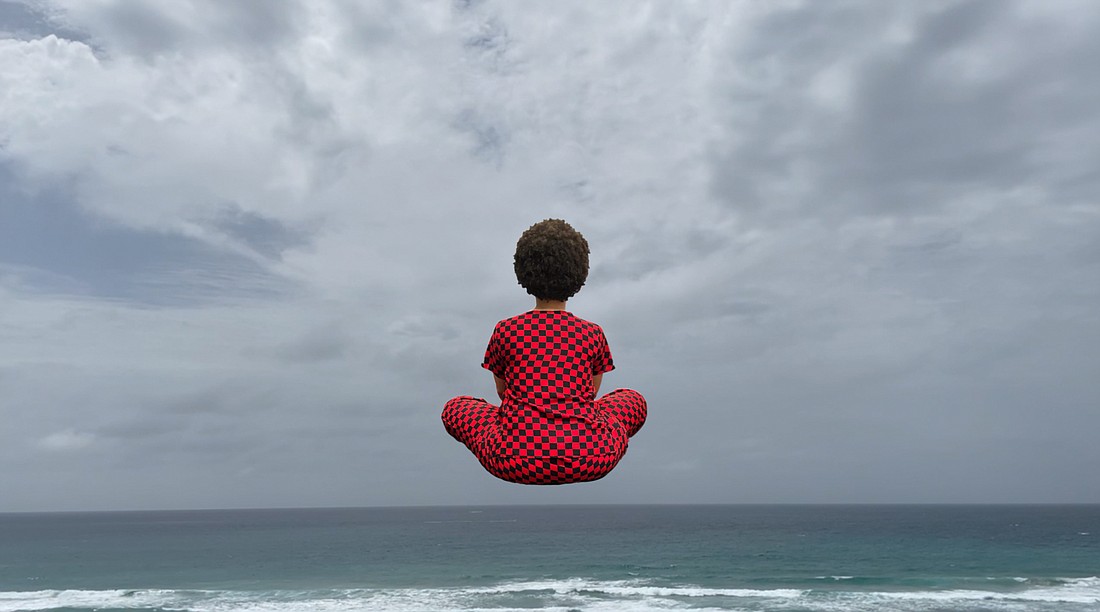- May 5, 2025
-
-
Loading

Loading

Be there or be square. The Beatnik-era saying needs a makeover in light of a bold new exhibition at the Sarasota Art Museum: Be there and see squares. Lots of them.
Stephanie J. Woods' exhibit "my papa used to play checkers” is filled with black and red squares like the ones on a checkerboard. Woods’ first one-woman at SAM show runs through Sept. 17.
The name of her installation in Sarasota is also the title of a 2022 work, an inkjet print of a watermelon, hand-dyed cotton fabric, hair beads, barrette bows and afro hair.
A visitor to the gallery that houses Woods’ exhibition soon discovers that there are no mistakes or oversights in her work. Even the smallest detail, like her full name in the title of her show, is intentional.
Woods is an assistant professor of interdisciplinary art at the University of New Mexico in Albuquerque. In 2021, she was awarded the 1858 Prize of Contemporary Southern Art by the Gibbes Museum of Art in Charleston, South Carolina, for her personal yet culturally resonant art.

Family is a dominant theme in the works of Woods, who was born in Seneca, South Carolina, and raised in Charlotte, North Carolina. Encouraged to learn sewing by her mother, Woods literally weaves childhood memories into her art.
Plastic evokes the slipcovers used to protect furniture in her grandparents’ home (and many others during that period).
Black hair, food, water and dirt are some of the other elements that play starring roles in Woods’ creations. Asked how she is able to suspend part of a sandcastle she built by hand on a beach within a hollowed-out melon without it disintegrating, Woods smiles and says, “I can’t give away all my secrets.”
Pressed further, she confesses, “Water.”
In a crowded talk on May 27 at SAM to discuss her installation and other works in her oeuvre, Woods cited a 2021 artist residency at Black Rock Senegal in Dakar as a life-changing experience, in terms of her art and her perceptions of herself, her family and her heritage.
She said she hadn’t thought about playing checkers with her grandfather (who she calls her “papa”) in a long time until she took a batik class in Senegal where she learned to create fabric with different colored squares using wax and dye.
A shopping trip to a local market in Dakar yielded a red-and-black checked fabric that she bought and fashioned into a jumpsuit.
An idea was germinating, and it was full of squares.
The ultimate manifestation also has a rectangle. It was inspired by the infamous “Door of No Return” located in a museum on an island near Dakar that is a memorial to the victims of the Atlantic slave trade.
But rather than being a symbol of departure, exile and even death, the door-like structure in Woods’ installation at SAM is about return. It is a testament to her exploration of the land of her ancestors and the connection she felt with people living in Africa today.
During her residency, Woods found joy in discovering how African traditions like making gumbo and playing checkers (known as “draughts”) survive in the U.S. today.
“I spent the past year wondering why I was so drawn to the checker pattern,” said Woods. “My interest in checkers stemmed from the time I spent with my papa and the memories we shared around this game.”
But that was only a starting point. Woods was in her studio in New Mexico one day listening to a podcast of a conversation between Helga Davis and artist Arthur Jafa on actualizing Black potential when she heard a snippet that hit home.
She shared it with those attending her talk at SAM. “If you sit down and you play chess or checkers, the board is flat. It’s a 2D thing, but fundamentally it is a symbolic enactment of human conflict and opposing interests,” she quoted Jafa as saying. “That’s why we find chess or checkers interesting, because they are life-like in that way.”
The game of life, if you will.
While Woods has mastered many art forms, she uses the talents of others to help create her work. She draws on the poems of her frequent collaborator, Laura Neal, and the musical compositions of her husband, Johannes Barfield.
Perhaps because her fellow artists know her well, these contributions don’t seem to be intrusions or afterthoughts; they are seamlessly integrated into “Stephanie J. Woods: my paper used to play checkers.”
“I have long wanted to bring poetry into the gallery space and have others’ voices respond to visual arts,” said Rangsook Yoon, senior curator at the Sarasota Art Museum, in a statement. “Woods’ stunning, spare installation opens up a contemplative space with colors, sound, words and images.”
The dominant piece in Woods’ SAM installation is a huge moving “audio photograph” called “your destination is in a different time zone.”
A rear view of the artist dressed in her black-and-red checked jumpsuit is superimposed on a seascape. It is accompanied by an original score by Barfield and a poem by Neal. The overall effect is haunting.
Even though you are in a dark gallery in Sarasota, you are indeed transported to a different time zone.